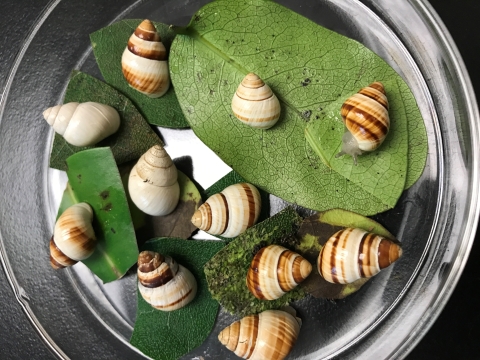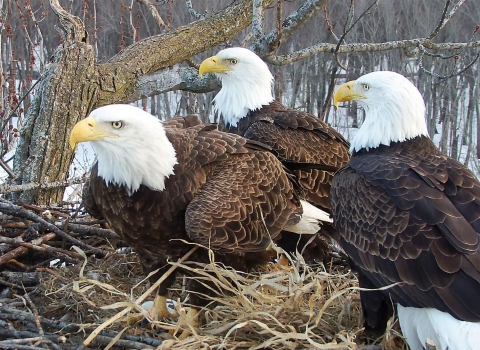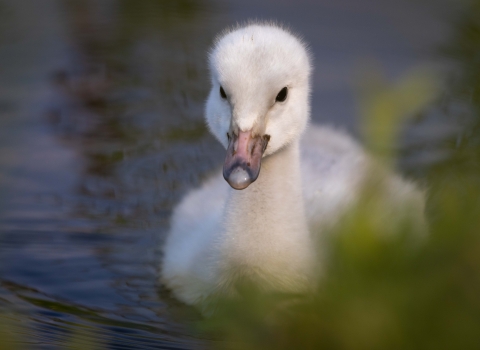Have you ever looked at a snail? Like, really looked?
I hadn’t up until a few weeks ago, after I spoke with Dr. Mike Hadfield at the University of Hawaii. Hadfield loves snails and has devoted much of his life to saving them from extinction. Aside from worrying about snails chewing up plants in my garden, I had never given them much thought.
So I decided to look. I looked at pictures and videos, and even outside in my own yard.
What I discovered is that kahuli, which is the Hawaiian word for snail, possess a sort of ancient, quiet beauty. Their shells can be a deep chocolate brown or a dazzling multi-colored swirl. Most of them move slowly—sluggishly, we might even say.
There were once more than 750 species of kahuli that couldn't be found anywhere else in the world. At least 60% of those snails have gone extinct. There are 44 Hawaiian snail species listed as endangered under the Endangered Species Act, 41 in just one genus, the Achatinella. There are many more unlisted species that face serious threats.
For decades, the U.S. Fish and Wildlife Service has supported snail conservation and recovery work in Hawaii, especially in partnership with the Hawaii Department of Land and Natural Resources. Some of that work involves captive breeding of the Oahu tree snail, a species that has been extinct in the wild since 1991.
I interviewed Hadfield about his lifelong work to protect snails. While the work has been slow, it hasn't been sluggish. It's been filled with remarkable passion, energy and resilience. You can listen to the podcast on YouTube below, or read on through this lightly edited transcript.
Dr. Mike Hadfield: I'm Professor Emeritus at the University of Hawaii. I joined the faculty here in 1968, and as emeritus I had appointments both in research and education. I went to school at the University of Washington and at Stanford. I spent the bulk of my time at Stanford at their marine laboratory, the Hopkins Marine Station in Pacific Grove. I was really a marine biologist by inclination and training, and my focus here has been on the biology of marine invertebrate larvae.
Lev Levy: Oahu tree snails are beautiful with shiny, colorful shells. These kahuli have been described as jewels of the forest and have been depicted as being able to sing in Hawaiian folklore. They occupy an important place in native Hawaiian culture, and traditional poetry, hula, Hawaiian lei and chants featured these long lived kahuli.
Hadfield: After I'd lived in Hawaii, gosh, about, you know, five or six years, I immediately became aware of this incredible endemic evolution that went on here in in plants, the silver swords, a lot of different plants, the wonderful radiations of the birds, the honey creepers and all those beautiful red birds and yellow birds, and then the tree snails.
I was pretty much an invertebrates man. And in those years, in the early 1970s, the graduate students in my lab were heavily focused on sort of energetics, you know, comparing very closely related species of snails, let's say, some of which make very large eggs and have development right through to little snails that crawl away when they hatched. I was trying to understand the evolutionary factors that lead to selection for these very diverse life history patterns.
I became aware of the Achatinella snails. They run, you know, from say, a centimeter to two centimeters long. They're brightly colored, and have wonderful patterns of banding, circular banding, and they have shells in browns and whites and various shades of ochre and even into yellows, reds, and pure black. They're very attractive, very large, and they were particularly well known.
The genus Achatinella on this island where I live on Oahu was about 42 species. That's an enormous radiation. We know the oldest rocks on Oahu are about 5 million years old and so we have no idea when the snails first got here, but any rate that's been quite a rate of evolution.
Levy: Because of their geographic isolation, the native species that evolved on the Hawaiian Islands often can't be found anywhere else in the world. These species have also evolved with fewer threats from predators or competing species. As a result, when invasive species invasive species
An invasive species is any plant or animal that has spread or been introduced into a new area where they are, or could, cause harm to the environment, economy, or human, animal, or plant health. Their unwelcome presence can destroy ecosystems and cost millions of dollars.
Learn more about invasive species do arrive in Hawaii, they cause immense destruction to native plants and animals. In the case of the kahuli, this destruction was caused by predators.
Hadfield: The very populations we were studying were disappearing. I mean really our snails were going away and we were finding them dead on the ground and that was because of predation.
When the Hawaiians arrived here 1000 years ago, there were Polynesian rats on their canoes and rats eat snails. The sailing ships brought two species of rats, the roof rat and the wharf rat from European ports and those became established. So then we had three predators 3 rats crawling around eating the snails. Then in the late 1930s a thing called the giant African snail was introduced to Hawaii and it made its way across the Indian Ocean throughout the Orient up into Japan and it got here.
The giant African snail is a big plant-eating snail and by the 1950s it was a garden pest. People were really upset because it was eating their orchids and their bromeliads and so forth. It was never really a major agricultural pest.
Levy: To deal with the African tree snail, other non-native carnivorous snails were introduced as biocontrols. One of these, the rosy wolfsnail, moved up into the mountains and started attacking native snails.
Hadfield: What we found in the mountains is often we'd have a nice robust population of Hawaiian tree snails we'd be studying, and then suddenly it would crash. What we would find is their beautiful shells. The rosy wolfsnail doesn't eat the shells. It simply shoots a big proboscis inside the shell and pulls the snail out and swallows it. So you find these beautiful shells on the ground. Rats do crunch up the shells, so you can always tell who's preying when you when you get there.
Levy: There have since been other introduced predators, including Jackson's chameleons and the New Guinea flatworm. The Oahu tree snail was once abundant. Then it nearly disappeared.
Hadfield: There is no evidence that the Hawaiian tree snails had any predators during this evolutionary period when they radiated. And you can imagine that that's very believable given this crazy non-adaptive life history, right? Slow growth, late maturity, low fecundity and so forth. And still, they were incredibly abundant. If you read descriptions of the snails in in the late 1880s or early 1900s, they talk about them hanging from the trees like clusters of grapes. I mean, you could just go and trees were full of them.
Levy: In 1981, the Service listed the Oahu tree snail as endangered under the Endangered Species Act. Ten years later, Dr. Hadfield collected 11 of the last species of these snails in the wild and began an experimental program to breed them in a lab. While it took some trial and error, Hadfield successfully started a captive breeding program. He later built exclosures or outdoor pens to protect the snails outside.
Hadfield: That led me to then start trying to see if we could bring them into captive propagation, and farm them literally in the lab. We knew that the snails have to feed on molds, bacteria, whatever is growing on the surface of leaves, we were bringing in bunches of leaves. We finally isolated one of these molds and got it growing in petri dishes on potato dextrose auger beautiful layers and and the auger you could sort of scoop it out of the petri dishes and the auger would stick to the wall of the Terraria and the snails ate it off. They loved it.
Finally I was able to scare up the money to buy some environmental chambers. The first one was a thing that looks exactly like your home refrigerator, except you could set day and night cycles and temperature cycles. You could make it warmer in the day and the sun came up and then in the evening the sun went away and it chilled down. We eventually got it going so we bought those plastic fish tanks you can buy at the pet store. We cut the bottom out and glued in screen window screen so that they wouldn't fill up with water. We figured out a way to put sprinkler systems in them, to spray them from the top so we could then run them on a day, night cycle, day night temperatures, and wet them frequently enough to keep them active.
We climbed into the mountains at least every other week and brought a great big bag of fresh leaf leafy branches of ‘Ōhi‘a trees in. We kept those then in in the refrigerator and we could take them out and replace them. We were growing our mold and we basically set up a captive rearing protocol that worked very, very well.
Levy: The first exclosure Hadfield and his colleagues built was primitive, but effective. It was an electric fence, about four feet tall and 4000 square feet, with barbed wire at the top, mostly to keep out the human types of animals. The scientists immediately observed that while the snails outside the exclosure disappeared, the snail population inside continued to thrive. That was a few decades ago. Now here you can hear Hadfield talking about the exclosures currently being used by David Sisco, a wildlife biologist with Hawaii's Department of Land and Natural Resources in the field.
Hadfield: Dave's predator exposures now are so state-of-the-art.They have big solar panels, closed-circuit TV so they can sit down in the center of the valley in civilization and see what's happening up at those things. If something sets off an alarm on the top of the fence, they can find out why. They're just incredible compared to the first one we built up in the Waiʻanae Mountains. The snails inside them are incredible.
Dave and his gang, they're doing multiple species in them, things that were sympatric to begin with. They're doing both tree snails and another family of snails that's endemic to the Hawaiian islands. They've literally snatched those from extinction and have hundreds of them now in the lab.
Levy: Hadfield emphasized the important role that his students and partnerships have played in his work. Hawaii's Department of Land and Natural Resources took over the captive propagation program and has poured an immense amount of time and resources into kahuli conservation. Hadfield also mentioned many of his students and colleagues by name, including David Cisco, who now works for the state, and Stephen Miller, who works for the service. There are dozens of others, many of whom started off as students in Hadfield's lab at the University of Hawaii. Hadfield credits Sisco and Hawaii's Department of Land and Natural Resources with making incredible progress towards conservation.
The Service has provided funding towards snail conservation work, including $2.5 million in Competitive State Wildlife Grants to the state of Hawaii. In addition to releasing the snails back into the wild, there will also be snails living at the Bishop Museum in Honolulu and the Honolulu Zoo.
The ultimate goal, of course, is to be able to have a world in which these kahuli can be out in the wild and thriving. But with so many predators still on the loose, that's not a reality today. Reintroducing the snails into exclosures is an important first step.
The Endangered Species Act has played a critical role in the recovery of the Oahu tree snail. With hard work and collaboration, we can continue to make progress towards sustainable native kahuli populations. This species has played such a critical role in Hawaiian culture and our environment, we don't want to imagine a future without it.
Hadfield: It's important because it conserves biodiversity. That’s now that sort of is a big statement, isn't it? You know, So what? Because we got a world that was full of all this incredible biology, which is the result we know, of millions and millions of years of evolution. And on these islands, that's unique. It isn't duplicated anywhere else. If you're going to learn from that, you have to keep it around. There's all this stuff you can still do. There's so much that can still be learned. And I mean learned about how life evolves in nature, how evolution works, how biology works, how diseases work. And you can't do it if it's gone. If it's extinct, it's gone. And extinction is forever. It really is forever. And so that's what all these efforts are trying to prevent is just the loss of biodiversity, the loss of basically living information.
For more information on snail conservation, you can visit the Hawaii Department of Land and Natural Resources Snail Extinction Prevention Program website and the Oahu tree snail species page on the US Fish and Wildlife Service website.







